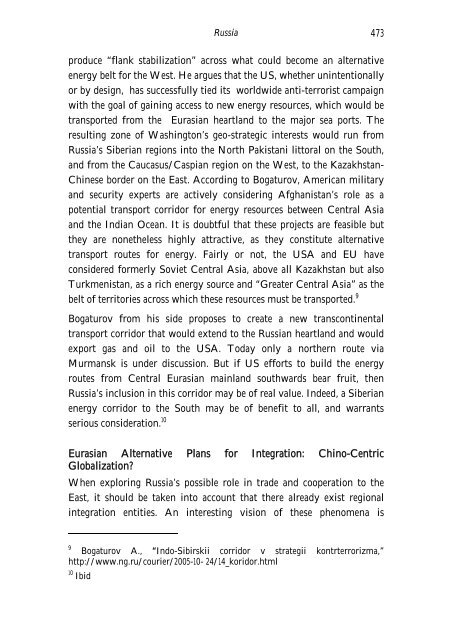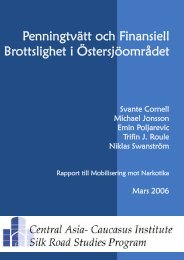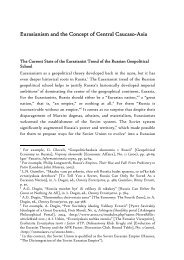Russia - Central Asia-Caucasus Institute and Silk Road Studies ...
Russia - Central Asia-Caucasus Institute and Silk Road Studies ...
Russia - Central Asia-Caucasus Institute and Silk Road Studies ...
Create successful ePaper yourself
Turn your PDF publications into a flip-book with our unique Google optimized e-Paper software.
<strong>Russia</strong> 473<br />
produce “flank stabilization” across what could become an alternative<br />
energy belt for the West. He argues that the US, whether unintentionally<br />
or by design, has successfully tied its worldwide anti-terrorist campaign<br />
with the goal of gaining access to new energy resources, which would be<br />
transported from the Eurasian heartl<strong>and</strong> to the major sea ports. The<br />
resulting zone of Washington’s geo-strategic interests would run from<br />
<strong>Russia</strong>’s Siberian regions into the North Pakistani littoral on the South,<br />
<strong>and</strong> from the <strong>Caucasus</strong>/Caspian region on the West, to the Kazakhstan-<br />
Chinese border on the East. According to Bogaturov, American military<br />
<strong>and</strong> security experts are actively considering Afghanistan’s role as a<br />
potential transport corridor for energy resources between <strong>Central</strong> <strong>Asia</strong><br />
<strong>and</strong> the Indian Ocean. It is doubtful that these projects are feasible but<br />
they are nonetheless highly attractive, as they constitute alternative<br />
transport routes for energy. Fairly or not, the USA <strong>and</strong> EU have<br />
considered formerly Soviet <strong>Central</strong> <strong>Asia</strong>, above all Kazakhstan but also<br />
Turkmenistan, as a rich energy source <strong>and</strong> “Greater <strong>Central</strong> <strong>Asia</strong>” as the<br />
belt of territories across which these resources must be transported. 9<br />
Bogaturov from his side proposes to create a new transcontinental<br />
transport corridor that would extend to the <strong>Russia</strong>n heartl<strong>and</strong> <strong>and</strong> would<br />
export gas <strong>and</strong> oil to the USA. Today only a northern route via<br />
Murmansk is under discussion. But if US efforts to build the energy<br />
routes from <strong>Central</strong> Eurasian mainl<strong>and</strong> southwards bear fruit, then<br />
<strong>Russia</strong>’s inclusion in this corridor may be of real value. Indeed, a Siberian<br />
energy corridor to the South may be of benefit to all, <strong>and</strong> warrants<br />
serious consideration. 10<br />
Eurasian Alternative Plans for Integration: Chino-Centric<br />
Globalization?<br />
When exploring <strong>Russia</strong>’s possible role in trade <strong>and</strong> cooperation to the<br />
East, it should be taken into account that there already exist regional<br />
integration entities. An interesting vision of these phenomena is<br />
9 Bogaturov A., “Indo-Sibirskii corridor v strategii kontrterrorizma,”<br />
http://www.ng.ru/courier/2005-10- 24/14_koridor.html<br />
10 Ibid






